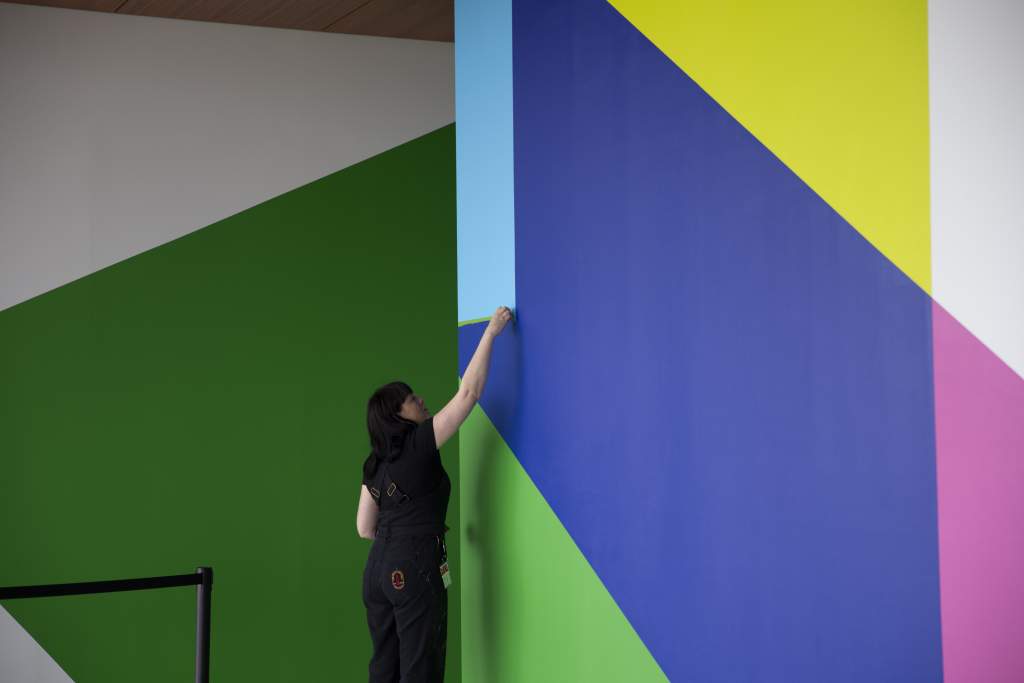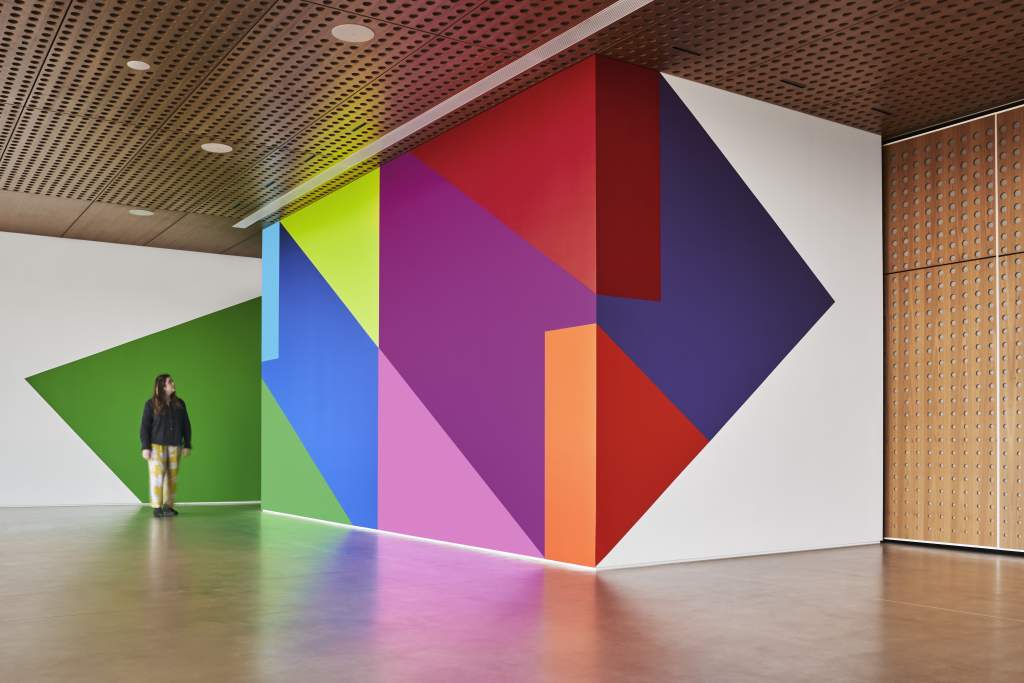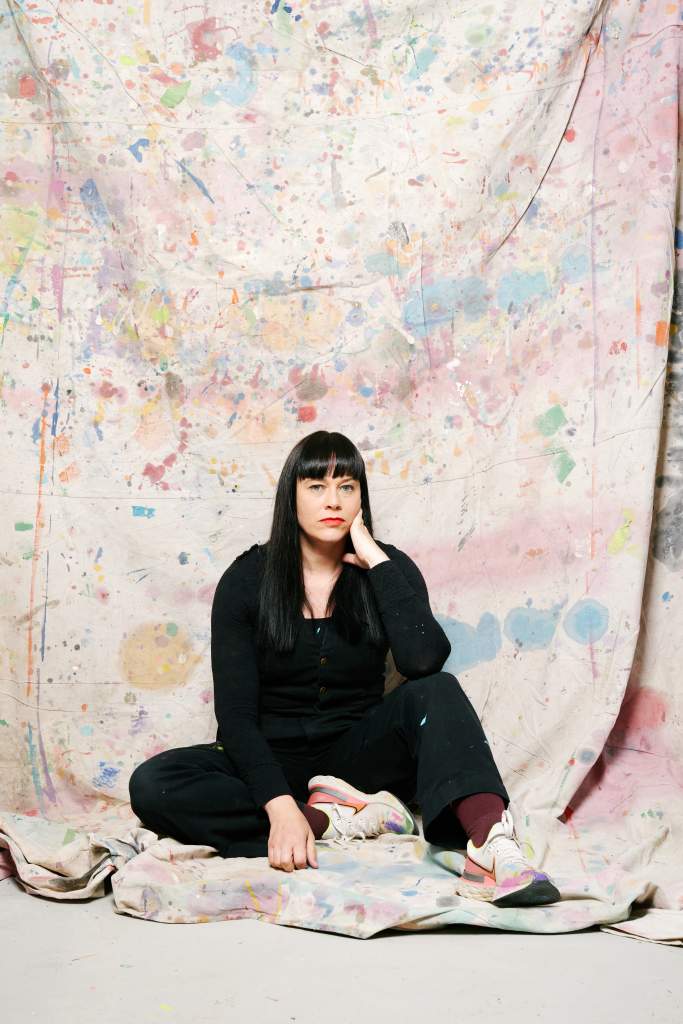
In conversation: Emma Coulter
In August 2023, Emma Coulter joined SAM for a conversation about her featured Art Wall exhibition spatial deconstruction #30 (social fabric).
Emma, your work is instantly recognisable through the colours that you use in each of your artworks. Tell us a bit about how you arrived at this colour palette, and how it came to be so definitive in your practice.
Colour is definitely the central idea in my work that connects almost 20 years of practice. I have always worked with colour, but in the last decade I have worked with a limited colour spectrum of up to nine colours, in a serial manner—that is, on a repetitive basis.
Having that rigour or discipline I believe has allowed me to work at variable scale, but also to focus on bigger conceptual ideas.
Colour, I believe has the power to reach across boundaries, and that is why I like to use it as a medium. It really links in with the overall philosophy of my practice that art should be accessible for everyone. With the colours being defined, I believe it also enables me the freedom to work across mediums. Through my work, I am developing an ongoing conceptual language, that can be extrapolated to suit each situation.
I see colour in the same way that a linguist might see letters, the letters make a word, the words make a sentence. I feel that I can manipulate my colours in the same way to create a deliberate outcome. The analogy of music is also a useful one. The permutations are endless really. Whilst each work is independent, they also each belong to an ever-evolving series or larger collection of works.
You’ve now created 30 works in your series of “spatial deconstructions”. Can you explain what it means to “deconstruct” a space, and what your deconstruction process consists of?
The ‘spatial deconstructions’ are a continuing numerical series of works that I’ve been creating since the beginning of 2014. In 2013, I had the opportunity to create a façade intervention for Pieces of Eight Gallery in Russell Place, Melbourne. It was through undertaking this project that I was inspired to further my experimentation of exploring both architectural and public space, in combination with my painting practice. My ‘spatial deconstruction’ works were the starting point for my Masters project at VCA – over the course of studying there, I completed 14 site-specific spatial deconstruction works over 2 years. This period was also a particularly formative time for me. I worked through my Masters with a sense of urgency, as being in that critical yet supported environment I understood to be rare.
The painted site-specific works started as a fairly intuitive response to space, and over time they have become much more refined and evolved. Each work in the series has a continuing number, and a word in parentheses afterwards which relates to the idea behind the work or the connection to the site.
The term ‘deconstruct’ is an abstract term in itself. Whilst the work is really a type of intervention, I created the term “spatial deconstruction”, because I’m responding to elements of the space, deconstructing them through my internal lens, and then reconstructing them into a new spatial work. I deconstruct selected elements that I see as important. I arrive at these elements through an intuitive process of research about the place and space. This can involve field research, oral research, investigations into texts, maps, plans and history. Formal concerns and aesthetics combine to inform the final outcome.
In these site-specific works there is always a strong contextual relationship. I use the term context broadly, as it can mean a lot of different things. To me context doesn’t necessarily mean the physical elements of the space – it might mean other things; for example, when I came up with the concepts for my metro tunnel work in Melbourne in 2021, the context was the social context of the time, of what was happening in Melbourne. The work was called spatial deconstruction #23 (resilience), because it was about the idea of resilience in Melbourne, resilience in the arts. Sometimes it contains social ideas, and sometimes it contains more literal ideas.
Subtle ideas for the community are contained within my work, and the more that you can engage with it, perhaps those ideas will become more obvious.

Emma Coulter installing spatial deconstruction #30 (social fabric) at SAM, August 2023. Photo: Mikela Guseli/Shepparton Art Museum
When you respond to an architectural space, what is it about that space that informs your final artwork?
I’ve touched on the idea of context already – and how I interpret that in my practice. My response is guided by what I uncover in that research and testing process in conjunction with the physical parameters and features of an architectural space.
In my work spatial propositions often synthesise contextual ideas as tools to reorganise meaning.
In terms of what I saw as important for this Art Wall, I spoke to (SAM Head of Exhibitions) Jessica O’Farrell and did my own research about the building, including primary research of physically being in the space, as well as listening to some of the architecture panel talks about the SAM project and understanding the architects’ intentions and ideas behind the design. I learned that the Level 4 space [location of Art Wall] is a very important space for the community, and that it connects the community to this brand-new art precinct, which might be a bit of an intimidating structure for some. The idea of Level 4 being the social fabric of the building became an overriding idea in making this work. The outcome is also layered with the abstracted geometry of the façade plates, as an intersection with my practice.
What were the elements of the SAM building and the shared/public spaces within it that you found the most interesting when creating this Art Wall commission?
One thing that struck me, and probably strikes a lot of other people, is the building’s verticality and dominant presence in the landscape. In my research, it was really interesting to discover that the verticality and the facade plates were really born out of the function of the building and the context of the site, not necessarily aesthetics. Obviously, formal elements are of high consideration in architectural design outcomes, but actually the height of the building was driven out of the site being located next to a lake in a flood zone, and the function is there to protect the art. The facade plates are also a really important for trying to organise the four different entry points, whilst creating energy efficiency in the building. That idea seemed important, and I wanted to highlight that through this work, so I took those ideas and synthesized them into a series of different test patterns and geometric shapes, working through various ideas that might work with my colour palette and theory. Through this ongoing process of abstraction
I finally arrived at a series of geometries that I was happy with, which I then worked with the curatorial team to finalise.
Once the geometry was decided, the colour relationships were refined further to create a work that ‘felt’ right. I guess that’s where it’s the collision of my practice with the space, whatever the space is that I’m working within. It’s also the process of abstraction, which might be something that a lot of people don’t understand – like for some, abstraction might just be viewed as a series of lines on a page, or a process of arbitrary decisions. But for me, the decisions that I make in my work are very purposeful and considered. It’s like, through the process of exhaustion they become very simple and simplified.
My final ideas are never the first outcome of me responding to a space. It takes a series of progressions and ideas before the idea gradually becomes resolved. With more gestural painted works, you can see all the process in the final product. In the techniques and processes that I use for abstraction, I arrive at the outcome through an exhaustive series of tests and drawings that happen between the realms of hand drawing and digital space. This enables me to work at scale, and to work with other people to help realise my work. With all the creative decisions being made – the final act of painting the work is more of a technical affair.

Emma Coulter, spatial deconstruction #30 (social fabric), Shepparton Art Museum, 2023. Photo: Leon Schoots
What do you hope viewers will take away from your Art Wall?
In my site-specific work I am driven by the idea that meaningful art can exist in the binaries of both cultural and everyday spaces, in order to enliven the experiences of both shared space and art for everyone.
I see colour as a medium that can transgress boundaries, because there is no correct meaning. In this way it offers different entry points into the work. I don’t believe that the deeper conceptual meaning that I hold as the artist needs to be understood by everyone in order to experience the work, but the complexity is there for those who do understand more about the history of art, or the building, and want to engage more deeply.
I hope my work brings more people that are curious about art to SAM, and also a wider audience to Shepparton, perhaps those from Melbourne that haven’t visited the new SAM yet. Both will have the opportunity to view the incredible collection in this ‘art container’.
I know that the top level of SAM is a destination for the local community to visit as it’s the only public space in Shepparton where you can get this unique, elevated view. It therefore makes sense to be the social fabric between the art, the audience, and the view. I hope that my work might provoke a new response to the space.
The idea that an artist can control the audience’s response to a work is not something that I aspire to. I’m open to people’s response to my work, as to me there is no ‘correct’ meaning. The interesting thing about working in public spaces is that you actually pass on the custodianship of your work to the local community, where it takes on a new life and meaning of its own.
spatial deconstruction #30 (social fabric) is on show at SAM from 19 August 2023 to 6 May 2024.
Featured image: Emma Coulter, spatial deconstruction #18, (doppel symmetrie) (detail), adhocraum, Bochum, Germany. Image courtesy of the artist


Image: Emma Coulter in her studio. Photo by Mia Mala McDonald.
About the Artist
Emma Coulter (b. 1978 Northern Ireland) lives and works between Melbourne and Macedon, Victoria. Coulter works with colour in a repetitive way; through a refined colour palette, she creates her own bold, idiosyncratic spectrum. Through abstraction, site-specificity, and colour, her work navigates cultural structures in consideration of art’s place in society.
Coulter holds a Bachelor of Visual Art and the Built Environment from Queensland University of Technology, Brisbane (2000), and a Master of Contemporary Art from Victorian College of the Arts, Melbourne (2015). Coulter’s works have been exhibited nationally and internationally. Her most recent projects include a large public art commission for Yarrila Place, Coffs Harbour’s new cultural centre (2023) and the recent commission of a 130-metre-long ‘spatial deconstruction’ at City Square, Melbourne, for the Metro Tunnel creative program (2021); as well as public art commissions for Footscray Community Arts Centre, Melbourne (2021), and QUT Art Museum, Brisbane (2021). Emma Coulter is represented by James Makin Gallery in Melbourne.
Curator: Jessica O'Farrell, Exhibitions Curator

Location: Furphy Family Art Wall, Level 4
Free

